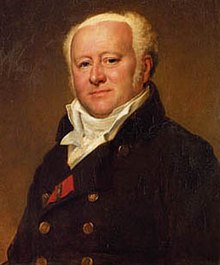Jean-Nicolas Corvisart | |
|---|---|
 Portrait by François Gérard | |
| Born | 15 February 1755 Dricourt, France |
| Died | 18 September 1821 (aged 66) Courbevoie, France |
Jean-Nicolas Corvisart-Desmarets (15 February 1755 – 18 September 1821) was a French physician.
Born in the village of Dricourt (now in Ardennes), Corvisart studied from 1777 at the Ecole de Médecine in Paris, later qualifying as docteur régent of the Faculté de Paris (1782).[1] In 1797, Corvisart began to teach at the Collège de France, where he gained a reputation as an expert in cardiology. Among his students were René Laennec, Guillaume Dupuytren, Xavier Bichat and Pierre Bretonneau.[2]
Corvisart resurrected percussion during the French Revolution after it had fallen out of fashion.[3] He emphasized the study of symptoms and examined postmortem evidence as well.[4] In 1808 Corvisart's translation of Leopold von Auenbrugg's Inventum Novum from Latin into French was published. Corvisart was especially fond of Auenbrugg's use of chest percussion as a diagnostic tool, and began to perfect the technique. In the meantime, Corvisart had become since 1804 the primary physician of Napoléon Bonaparte, who he would continue to attend to until Bonaparte's exile to St. Helena Island, October 1815. In 1820 he was made a member of Académie Nationale de Médecine. He died the following year at Courbevoie.[1]
- ^ a b Napoleon.org Corvisart, Jean-Nicolas (1755–1821), Physician to the Emperor
- ^ Baron Jean-Nicolas Corvisart des Marets Dricourt 1755 - Paris 1821 Baillement.com
- ^ Gabbay, John (1989-01-01). "Clinical Medicine In Revolution: 2: Fusion In The Crucible". BMJ: British Medical Journal. 299 (6692): 166–169. doi:10.1136/bmj.299.6692.166. JSTOR 29704703. PMC 1837051. PMID 2504361.
- ^ Cantwell, J. D. (1988). "Jean-nicolas corvisart". Clinical Cardiology. 11 (11): 801–803. doi:10.1002/clc.4960111115. PMID 3069259. S2CID 28745565.